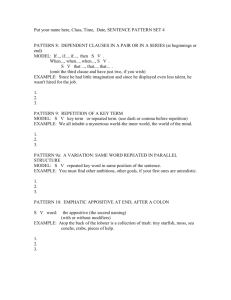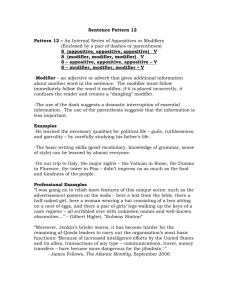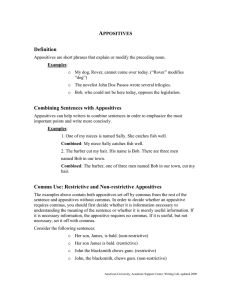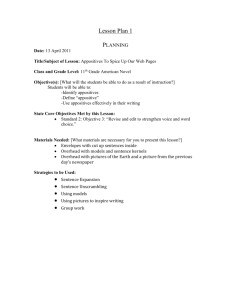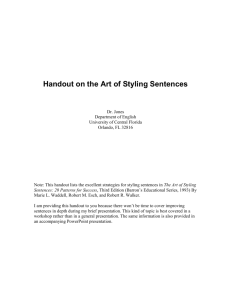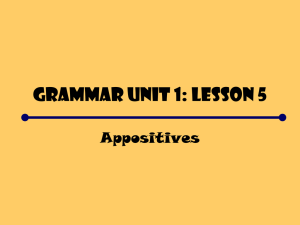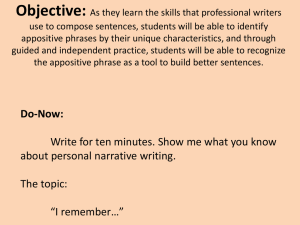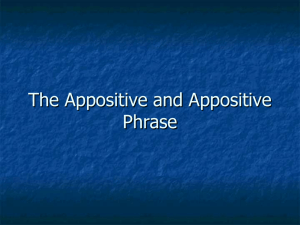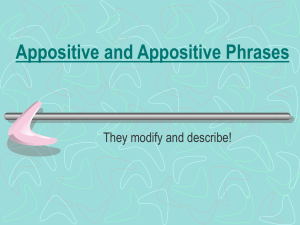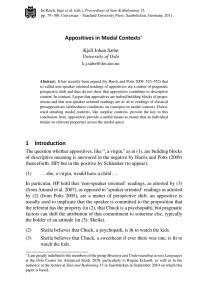Sentence Fluency
advertisement
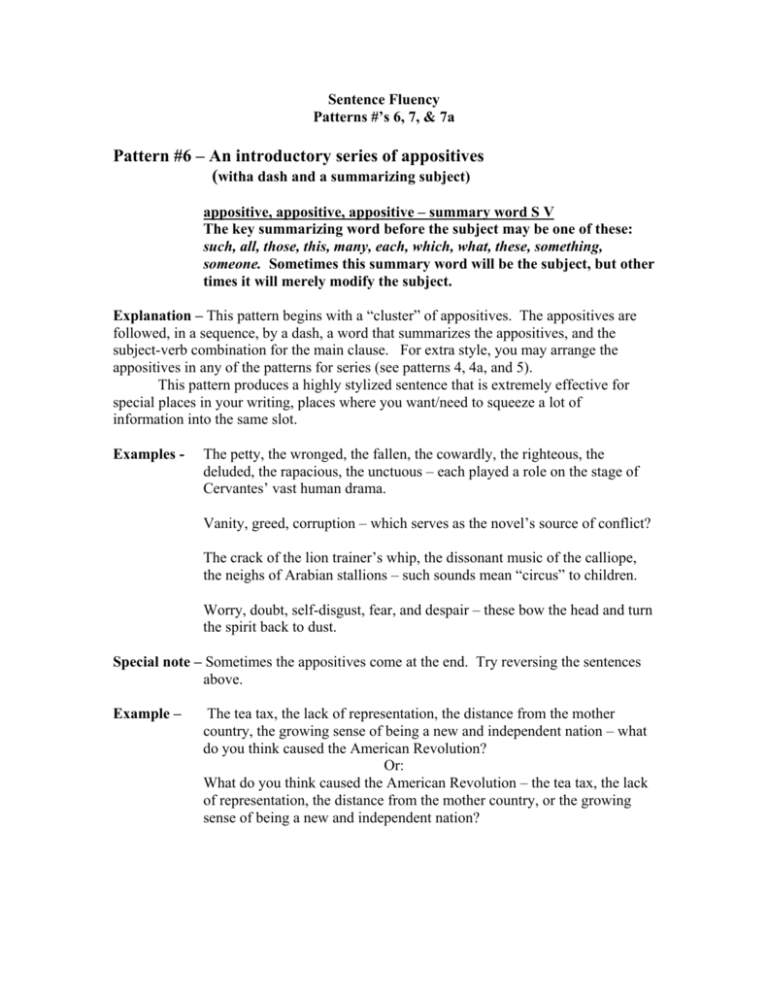
Sentence Fluency Patterns #’s 6, 7, & 7a Pattern #6 – An introductory series of appositives (witha dash and a summarizing subject) appositive, appositive, appositive – summary word S V The key summarizing word before the subject may be one of these: such, all, those, this, many, each, which, what, these, something, someone. Sometimes this summary word will be the subject, but other times it will merely modify the subject. Explanation – This pattern begins with a “cluster” of appositives. The appositives are followed, in a sequence, by a dash, a word that summarizes the appositives, and the subject-verb combination for the main clause. For extra style, you may arrange the appositives in any of the patterns for series (see patterns 4, 4a, and 5). This pattern produces a highly stylized sentence that is extremely effective for special places in your writing, places where you want/need to squeeze a lot of information into the same slot. Examples - The petty, the wronged, the fallen, the cowardly, the righteous, the deluded, the rapacious, the unctuous – each played a role on the stage of Cervantes’ vast human drama. Vanity, greed, corruption – which serves as the novel’s source of conflict? The crack of the lion trainer’s whip, the dissonant music of the calliope, the neighs of Arabian stallions – such sounds mean “circus” to children. Worry, doubt, self-disgust, fear, and despair – these bow the head and turn the spirit back to dust. Special note – Sometimes the appositives come at the end. Try reversing the sentences above. Example – The tea tax, the lack of representation, the distance from the mother country, the growing sense of being a new and independent nation – what do you think caused the American Revolution? Or: What do you think caused the American Revolution – the tea tax, the lack of representation, the distance from the mother country, or the growing sense of being a new and independent nation? Pattern #7 – An internal series of appositives or modifiers (enclosed by a pair of dashes or parentheses) S - or ( appositive, appositive, appositive – or ) V Modifier, modifier, modifier_____________ Explanation – The beginning of the sentence (or the end) is not the only place where you may have a series of appositives or modifiers. Appositives will rename and modifiers will describe something named elsewhere in the sentence. Any kind of series (see patterns 4, 4a, & 5) may come between the subject and the verb, between two subjects, and so on. Because this kind of series is as dramatic interruption within the sentence and may even have commas between the items, there must be a dash before and a dash after it. But when would you select parentheses to enclose the appositives or modifiers? Parentheses set off information that is less important or could even be omitted. It’s as if you have your hand to your lips to conceal what you’re saying or to direct your message to a special audience. Think of an actor on stage whispering something to another character or the audience in an aside. Modifiers, unlike appositives, are not substitutes for other words. Although both appositives and modifiers are movable, a modifier must follow closely the word group it describes. Beware of the dreaded “dangling” construction. Examples - The necessary qualities of political life – guile, ruthlessness, and garrulity – he learned by carefully studying his father’s life. My favorite red wines – Zinfandel, Cabernet, Pinot Noir – blend well in making rose wines. The much despised predators – mountain lions, timber wolves, and grizzly bears – have been shot, trapped, and poisoned so relentlessly for so long that they have nearly vanished from their old haunts. Pattern #7a – A variation: A single appositive or a pair S - or ( or , appositive - or ) or , V Use dashes, commas or parentheses to enclose this appositive Explanation – This pattern is essentially like pattern 7 except that it has only one or two items for the appositive instead of a full series. Here, the appositive may or may not have modifiers. In this variation, there is also an interesting interruption in thought immediately after the subject, but the appositive can have a variety of effects, depending on your punctuation: • Dashes make the appositive dramatic • Parentheses make it almost whisper • Commas will be the least conspicuous because they are so ordinary Examples - A sudden explosion – artillery fire – signaled the beginning of a barrage. A familiar smell – fresh blood – assailed his jungle-trained nostrils A popular theory among climatologists (the greenhouse effect) suggests how the earth’s changing temperature threatens humanity. Star Trek’s most famous motto – “Live long and prosper!” – proved to be downright prophetic.
